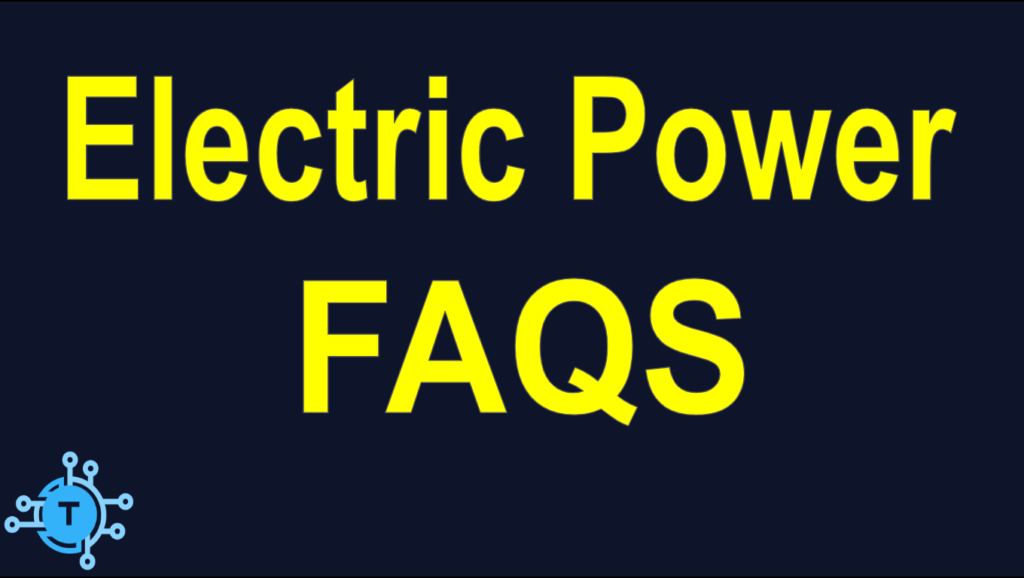
Frequently Asked Questions about Electric Power is another in a series of FAQS about electricity and electronics that are oriented toward Appliance Technicians and HVAC Technicians.
Frequently Asked Questions about Electric Power
Q. What is Electric Power?
A. It is the rate at which electrical energy is transferred to a Load by a circuit.
Q. How is Electric Power measured?
A. In Watts.
Q. Why is Electric Power important?
A. It is the whole point of using electricity. It is the rate of movement of existing energy in Joules from one form (such as coal) and location (power plant), to the ultimate end-point, the “Load”.
Q. What is a Joule and how does it relate to Electric Power?
A. A Joule is the unit of energy. It is the amount of energy required to lift an apple to a height of one meter. The Watt is the transfer of one Joule of energy to a Load per second. Thus a Load that dissipates one Watt is using one Joule of energy per second.
Q. What is a Load and how does it relate to Electric Power?
A. The load is the final destination and the reason for producing and transferring electrical power. The load performs work for us.
Q. How is Electric Power generated?
A. Energy already exists in many forms. It cannot be created nor destroyed, but rather only moved from one location and form to another. A kilogram of coal contains 29,307,600 Joules of potential energy. Coal, for example, is burned, the heat of which boils water. The steam from that water turns a turbine, which turns a generator. This is mechanical energy. The generator converts that mechanical energy into electrical energy, which is transferred along power lines, and ultimately ends up at the Load, or the heating element, for example.
Q. What is a Load and how does it relate to Electric Power?
A. The load is the final destination and the reason for producing and transferring electrical power. The load performs work for us. The one kilogram of coal, for example, contains enough energy to “Power” a dryer heating element for 1.4 hours. This is because at 5760W, or 5760 Joules per second, that aforementioned 29,307,600 Joules of energy the lump of coal contains, can power the element for 29,307,600 / 5760 or 5088 seconds, which is 1.4 hours.
Q. What is “Work” and how does it relate to Electric Power?
A. Work is the electrical energy is transferred to the Load, also known as the Joule. The more Joules of energy that is transferred per second, the greater the amount of work per second, or Watts of power is being transferred.
Q. How to you calculate Electric Power?
A. Some of Joule’s Electric Power equations are P = E x I, P = E2 / R, and P = I2 x R, where P is Power, E is voltage, and I is current. Related derivations are I = P / E, R = E2 / P, and R = P / I2
Q. How is electric power released by a motor?
A. A motor primarily converts the electrical energy into heat and mechanical energy.
Q. Are the Power equations part of Ohm’s Law?
A. Joule’s Power equations often found accompanying Ohm’s Law equations, but are not part of Ohm’s Law.
Q. Can Ohm’s Law be used to determine Electric Power?
A. It can be used to help find power by finding current, for example, as an input into a Power equation.
Q. What happens to the Electric Power dissipated by a heating element if you double the voltage?
A. The Power dissipated by the element quadruples, since Power output is the square of the voltage across a fixed resistance.
Q. What happens to the Electric Power dissipated by a heating element if you cut the voltage in half?
A. Conversely to the previous question, it drops by a factor of four.
Q. How is knowledge of Electric Power important to field technicians?
A. There are numerous examples. One is, that suppose you had an electric oven that was intermittently overheating. The broil and bake elements are supposed to “toggle” back and forth, during pre-heat, but not both be on at the same time. You suspected that the broil element relay was sticking. You knew the wattage of both the bake and broil elements from the schematic. From that, you calculated the current draw of each element using I = P / E. Knowing they are in parallel, you would know that if they were both on simultaneously, that the current from each element would add together. You monitored the L2 line and determined that during preheat, the current was intermittently equal to the sum of both elements’ current and determined that the broil relay was intermittently sticking.
To donate to the Tech Circuit – CLICK HERE
For additional electrical and electronics learning material for field techs, visit our homepage at http://www.TechCircuit.org or our Facebook group at https://www.facebook.com/groups/746823709133603 or our YouTube Channel
at https://www.youtube.com/@TheTechCircuit
TC
We are a participant in the Amazon Services LLC Associates Program, an affiliate advertising program designed to provide a means for us to earn fees by linking to Amazon.com and affiliated sites.
